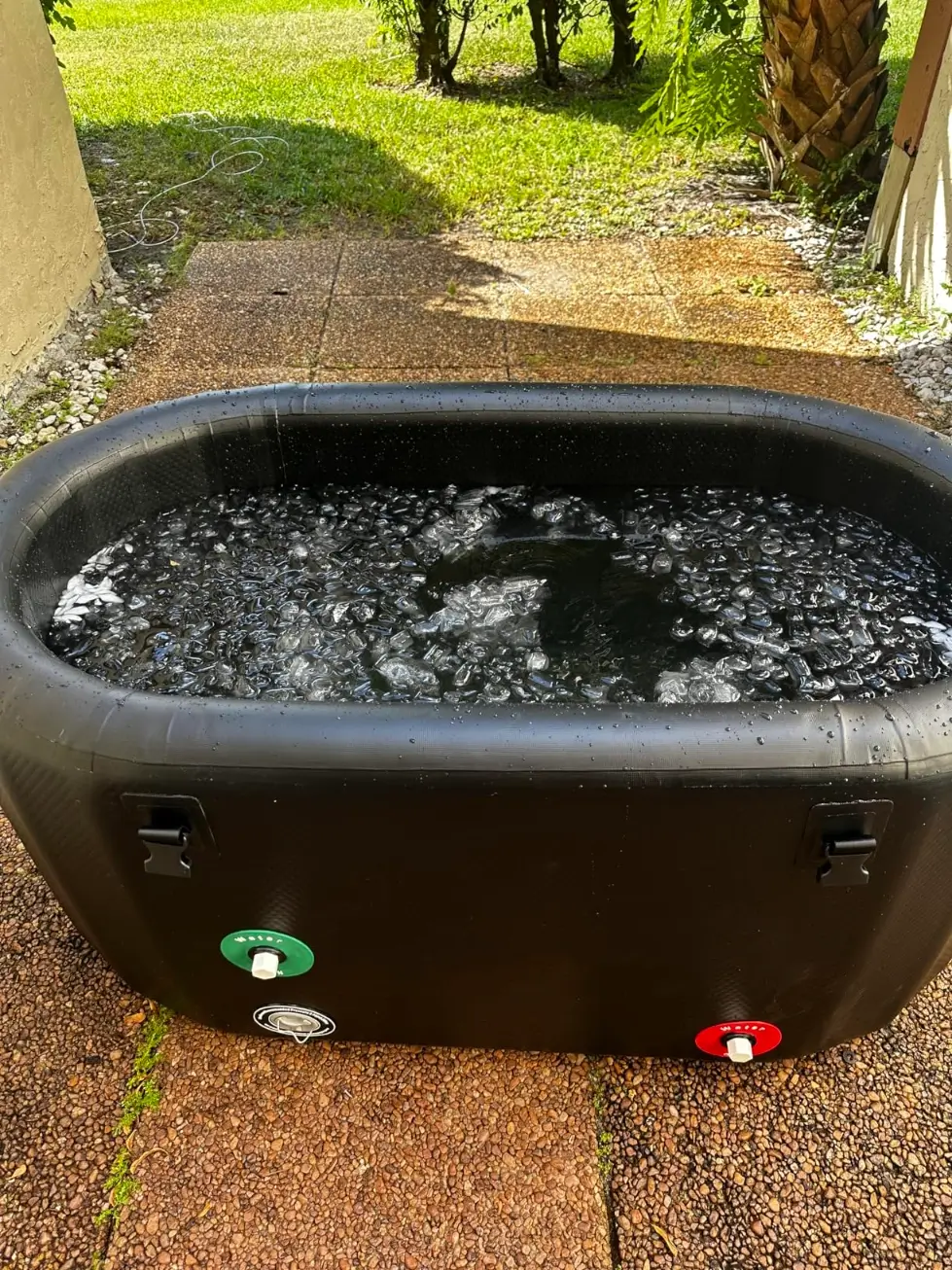5 Differences Between Ice Baths and Cold Showers
5 Differences Between Ice Baths and Cold Showers
Ice baths and cold showers are both methods of body cooling using cold water, but there are some differences between them:
1.Cooling rates in water baths, ice baths
An ice bath is the immersion of an object in a mixture of ice and water. Because of the low temperature of the medium (near 0°C or 32°F), it provides a very intense and rapid cooling effect. Ice baths quickly lower skin temperature, promote vasoconstriction, reduce muscle pain and inflammation, and increase the body’s rate of recovery.
In contrast, cold showers are usually slightly warmer, usually between 10°C (50°F) and 20°C (68°F), and have a slightly weaker cooling effect than ice baths, but still provide a cool and soothing sensation.
FURTHER READING

2.Type of immersion
An ice bath is a complete immersion of the body in ice water, usually in a bathtub or vat. This full-body immersion allows the ice water to fully cover the entire surface of the body, allowing for rapid cooling of the entire body.
A cold shower, on the other hand, involves spraying cold water directly over the surface of the body, usually through a shower head or nozzle. Cold showers are primarily a localized cooler, especially for body parts that are exposed to the flow of water.
3.Convenience
Ice baths require sufficient ice or ice water and equipment for immersion, such as a bathtub or large bucket. In contrast, cold showers are more convenient, requiring only the adjustment of the temperature of the faucet.
Of course, you can also try a portable ice bucket for ice bathing, which is inexpensive and collapsible (minimum fuss, maximum comfort).

4.Duration
Due to the much cooler temperatures of ice baths, the recommended soaking time is usually shorter, typically 15 to 20 minutes. If you want to achieve the same results, a cold shower can certainly be longer than an ice bath.
5.Feeling and comfort
The cooling effect of an ice bath is more intense and may cause shivering and a tingling sensation on the skin, which may feel uncomfortable or even unbearable for some people.
In contrast, cold showers are slightly warmer than ice baths and may be more tolerable.
So, if you’re just thinking about trying an ice bath, start slowly with a cold shower!

Choosing Wisely: Ice Baths or Cold Showers?
Summary of Key Differences
In the realm of cold therapy, ice baths and cold showers stand out as popular methods with distinct characteristics. Ice baths, with their frigid temperatures ranging from 50-59°F, provide intense cooling effects that trigger vasoconstriction and promote rapid muscle recovery.
On the other hand, cold showers offer a more moderate experience with temperatures around 68-72°F, stimulating metabolism and boosting energy levels through increased heart rate. These temperature variations lead to diverse physiological responses in the body, emphasizing that each method offers unique benefits tailored to different needs.
Aligning Personal Goals and Preferences
When deciding between ice baths and cold showers, it is crucial to consider personal goals and preferences in terms of physical recovery, mental resilience, and overall well-being. Athletes or individuals seeking quick muscle recovery may lean towards the invigorating plunge of an ice bath, relishing its immediate impact on circulation and inflammation reduction.
Conversely, those inclined towards a daily wellness routine focused on mental rejuvenation might find solace in the refreshing embrace of a cold shower’s mood-boosting effects.
Whether opting for the bracing chill of an ice bath or relishing in the enlivening cascade of a cold shower, the key lies in understanding one’s aspirations and selecting a practice that not only fulfills them but also enriches daily life.
May your exploration into the world of icy rejuvenation bring you closer to achieving your optimal state of well-being, one invigorating dip at a time!
Vestibulum ante ipsum
5 Differences Between Ice Baths and Cold Showers
Ice baths and cold showers are both methods of body cooling using cold water, but there are some differences between them:
1.Cooling rates in water baths, ice baths
An ice bath is the immersion of an object in a mixture of ice and water. Because of the low temperature of the medium (near 0°C or 32°F), it provides a very intense and rapid cooling effect. Ice baths quickly lower skin temperature, promote vasoconstriction, reduce muscle pain and inflammation, and increase the body’s rate of recovery.
In contrast, cold showers are usually slightly warmer, usually between 10°C (50°F) and 20°C (68°F), and have a slightly weaker cooling effect than ice baths, but still provide a cool and soothing sensation.
FURTHER READING

2.Type of immersion
An ice bath is a complete immersion of the body in ice water, usually in a bathtub or vat. This full-body immersion allows the ice water to fully cover the entire surface of the body, allowing for rapid cooling of the entire body.
A cold shower, on the other hand, involves spraying cold water directly over the surface of the body, usually through a shower head or nozzle. Cold showers are primarily a localized cooler, especially for body parts that are exposed to the flow of water.
3.Convenience
Ice baths require sufficient ice or ice water and equipment for immersion, such as a bathtub or large bucket. In contrast, cold showers are more convenient, requiring only the adjustment of the temperature of the faucet.
Of course, you can also try a portable ice bucket for ice bathing, which is inexpensive and collapsible (minimum fuss, maximum comfort).

4.Duration
Due to the much cooler temperatures of ice baths, the recommended soaking time is usually shorter, typically 15 to 20 minutes. If you want to achieve the same results, a cold shower can certainly be longer than an ice bath.
5.Feeling and comfort
The cooling effect of an ice bath is more intense and may cause shivering and a tingling sensation on the skin, which may feel uncomfortable or even unbearable for some people.
In contrast, cold showers are slightly warmer than ice baths and may be more tolerable.
So, if you’re just thinking about trying an ice bath, start slowly with a cold shower!

Choosing Wisely: Ice Baths or Cold Showers?
Summary of Key Differences
In the realm of cold therapy, ice baths and cold showers stand out as popular methods with distinct characteristics. Ice baths, with their frigid temperatures ranging from 50-59°F, provide intense cooling effects that trigger vasoconstriction and promote rapid muscle recovery.
On the other hand, cold showers offer a more moderate experience with temperatures around 68-72°F, stimulating metabolism and boosting energy levels through increased heart rate. These temperature variations lead to diverse physiological responses in the body, emphasizing that each method offers unique benefits tailored to different needs.
Aligning Personal Goals and Preferences
When deciding between ice baths and cold showers, it is crucial to consider personal goals and preferences in terms of physical recovery, mental resilience, and overall well-being. Athletes or individuals seeking quick muscle recovery may lean towards the invigorating plunge of an ice bath, relishing its immediate impact on circulation and inflammation reduction.
Conversely, those inclined towards a daily wellness routine focused on mental rejuvenation might find solace in the refreshing embrace of a cold shower’s mood-boosting effects.
Whether opting for the bracing chill of an ice bath or relishing in the enlivening cascade of a cold shower, the key lies in understanding one’s aspirations and selecting a practice that not only fulfills them but also enriches daily life.
May your exploration into the world of icy rejuvenation bring you closer to achieving your optimal state of well-being, one invigorating dip at a time!
About ther Author

Welcome to our blog! My name is peter and I am the lead author of this blog. As a sport recovery practitioner and with deep interests and expertise.
I am committed to presenting complex concepts in a clear and concise manner, and enabling readers to better understand and apply that knowledge through in-depth research and experience sharing.
Thank you for reading and for your support! If you have questions or suggestions about any of the content, please feel free to contact me. I look forward to sharing more interesting and useful information with you and growing together on this journey of knowledge!
